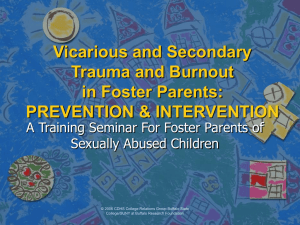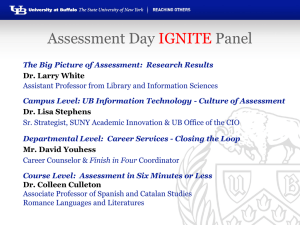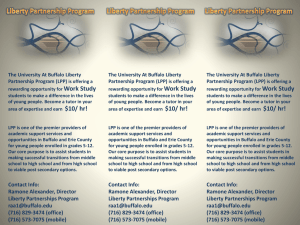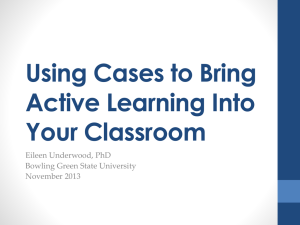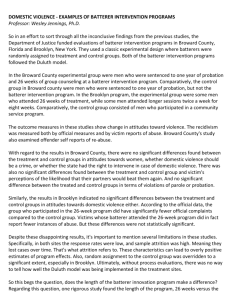Module 5
advertisement
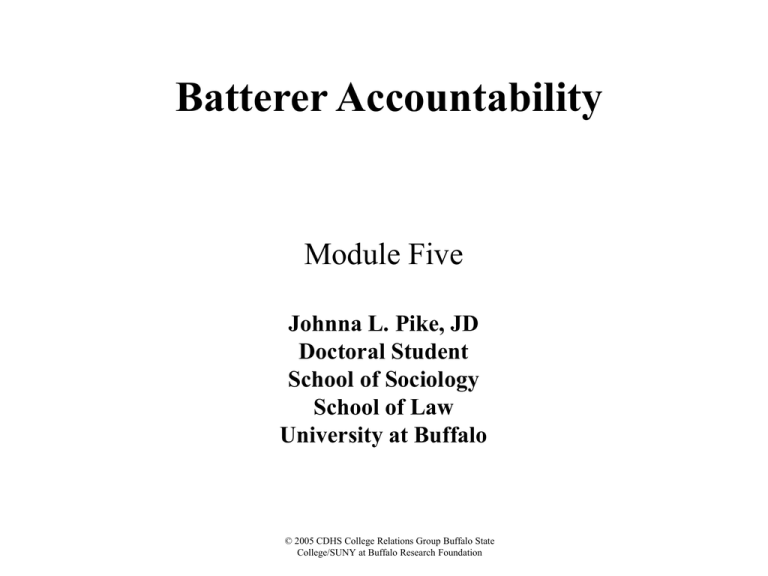
Batterer Accountability Module Five Johnna L. Pike, JD Doctoral Student School of Sociology School of Law University at Buffalo © 2005 CDHS College Relations Group Buffalo State College/SUNY at Buffalo Research Foundation Battered Parent with Children A battered parent continuously makes assessments of how best to protect herself and her children. = Most want the violence to stop but not all want to end the relationship. = If a battered parent does decide to separate from her batterer, she faces many obstacles and risks = Ending the relationship is generally a process of several separations and failed reconciliations. = Research suggests efforts to end violence greatest when child abuse is present. = © 2005 CDHS College Relations Group Buffalo State College/SUNY at Buffalo Research Foundation Suggested Guiding Philosophy for Cases with IPV Disfavor removing a child from the custody of the IPV victim to avoid further trauma = Screen for the existence of IPV in the home = Investigate and assess the nature and extent of IPV = Hold the Batterer Accountable = Make protection of IPV victim and children a priority = Service planning for both child and battered parent to foster trust and to encourage cooperation = © 2005 CDHS College Relations Group Buffalo State College/SUNY at Buffalo Research Foundation How is Child Safety achieved through Batterer Accountability? = Holding a batterer accountable provides some certainty of protection for a child from further exposure to IPV because: =child will no longer be exposed to batterer or... =batterer will stop his violence. © 2005 CDHS College Relations Group Buffalo State College/SUNY at Buffalo Research Foundation How should batterer accountability be determined? = In child welfare cases, it requires asking two questions: =Are we holding the batterer responsible for the outcomes caused by the violence? =By holding the batterer accountable, are we ensuring the children's safety? = A positive response to both questions will help shift the focus away from the battered parent. © 2005 CDHS College Relations Group Buffalo State College/SUNY at Buffalo Research Foundation Establishing Batterer Accountability = The legal system provides several avenues for holding batterers accountable for their violent behavior: = = = = Child Welfare System Criminal Justice System Domestic Relations System Specialized Courts © 2005 CDHS College Relations Group Buffalo State College/SUNY at Buffalo Research Foundation Batterer Accountability in the Child Welfare System = Opportunities for holding batterers accountable: = = = = Investigations and the substantiation of child abuse or neglect Adjudication of child abuse or neglect Service planning following adjudication Termination of parental rights proceedings © 2005 CDHS College Relations Group Buffalo State College/SUNY at Buffalo Research Foundation Investigation • • • • • • Approach batterer cautiously Obtain the batterer's account of the incident Listen critically, batterers often minimize, deny or justify behavior or blame the victim Determine risk level Document concisely Hold batterer accountable by substantiating the allegations against the batterer. © 2005 CDHS College Relations Group Buffalo State College/SUNY at Buffalo Research Foundation Service Planning For The Batterer = = Tie plan to batterer's acknowledgment of his responsibility for the harm done and the risk it posed to the child(ren). Remove continued risks posed by the batterer: = = = = Court ordered programs to reduce violence Orders of protection limiting or suspending contact Supervised visitation and exchange Court can hold review hearings every six months to ensure batterer compliance. © 2005 CDHS College Relations Group Buffalo State College/SUNY at Buffalo Research Foundation Service Planning for the Battered Parent • Individualize plan that avoids making her responsible for preventing batterer's violence • Assist with safety plan = = Build on established protective factors. Consider safety of both victim and her children • Make effective referrals (i.e. to IPV advocate) = Avoid programs requiring cooperative participation. • Recognize victim's strategies may conflict with service plan and thus it may require review and modification. © 2005 CDHS College Relations Group Buffalo State College/SUNY at Buffalo Research Foundation Service Planning for Children = = = = = Permit non-offending parent to be pro-active in the service planning of her children Provide supportive services Provide access to a continuum of specialized services for children exposed to IPV Support bond with non-offending parent Safety Planning in order to eliminate or manage an immediate or impending safety threat. © 2005 CDHS College Relations Group Buffalo State College/SUNY at Buffalo Research Foundation Safety Planning for Children and Battered Mothers = Goals of safety planning should include: = = = = teach children safety skills and critical thinking assist mother in protecting her child(ren) build an empowering relationship between the mother and the child(ren) develop for the child's cognitive and moral capabilities © 2005 CDHS College Relations Group Buffalo State College/SUNY at Buffalo Research Foundation Questions to ask Regarding Children's Safety Planning = = = = = What is the age-appropriate safety planning? To what extent should children participate in the process? How is a learning environment created for children that does not foster false promises of safety, exacerbate the fears of children or facilitate father's retaliation? Is safety planning more hazardous than helpful? Is safety planning more time-consuming than productive? © 2005 CDHS College Relations Group Buffalo State College/SUNY at Buffalo Research Foundation Elements to Children's Safety Plans = = = = = Visitation arrangements should be specific to protecting child and mother against anticipated dangers. Rehearse safety plan with children. Plan must address torn loyalties, sense of betrayal, and issues of self-blame. Teach children to enlist emergency assistance Teach children potential escape routes © 2005 CDHS College Relations Group Buffalo State College/SUNY at Buffalo Research Foundation Risks of Safety Planning with Children = = = = = = Fear will escalate beyond reality of danger Child will believe s/he can stop the abuse Child will feel at fault if the safety plan fails Mother who engages in safety planning potentially will be viewed by the court as an unfriendly parent. Child will become angry or disillusioned if court or others do not protect mothers despite safety plan. No amount of planning can be successful if the offender has continued access to the family © 2005 CDHS College Relations Group Buffalo State College/SUNY at Buffalo Research Foundation Termination of Parental Rights = = Terminating batterer's parental rights is the ultimate batterer accountability tool TPR forces batterers to accept that as a result of their violent behavior they are no longer entitled to parent their children. © 2005 CDHS College Relations Group Buffalo State College/SUNY at Buffalo Research Foundation Batterer Accountability in the Criminal System = = Notice to batterer that they are being held responsible for their behavior and provides a means to shield child from further exposure. Batterers can be prosecuted for the events that brought the family to the attention of Child Protection Services as well as for other older incidents © 2005 CDHS College Relations Group Buffalo State College/SUNY at Buffalo Research Foundation Conditions that Could be Imposed on Batterer = = = = = = = = preclude contact removal from home compliance with CPS conditions and service plan counseling specific to the child's needs a showing that batter no longer poses a danger probation which can be monitored through cooperative relationship with probation officer imprisonment prosecution for violations of court issued orders © 2005 CDHS College Relations Group Buffalo State College/SUNY at Buffalo Research Foundation Unrelated Boyfriends = Present a difficult problem for CPS: = = = May not feel mandate extends to these men even if their violence was reason for initial intervention If boyfriend cares for child(ren) then services should be extended to him If boyfriend does not care then... =battered mother will require services and support =CPS will likely have to use criminal system to separate batterer from child(ren) © 2005 CDHS College Relations Group Buffalo State College/SUNY at Buffalo Research Foundation Facilitating Victim's Participation in Justice System = = = Know and understand victims' rights in order to accurately inform them. Provide information about the legal process and make appropriate referrals for advocacy assistance. Follow-up with victims: =gather further information =identify risks of batterer retaliation =offer clarification = Allow victim input in the process and potential remedies © 2005 CDHS College Relations Group Buffalo State College/SUNY at Buffalo Research Foundation Domestic Relations Law and Batterer Accountability = Civil Order of Protection Proceedings: = = = = Can assist battered parent in gathering evidence to demonstrate IPV incident took place Can testify on behalf of battered parent Can obtain OP on behalf of the child Can assess whether obtaining child support as part of OP is a positive option © 2005 CDHS College Relations Group Buffalo State College/SUNY at Buffalo Research Foundation Domestic Relations Law and Batterer Accountability = Custody and Visitation Proceedings: = = = Can serve as an exit strategy from child protection case if CPS is willing to work with battered parent Judges are required to consider effects of adult IPV in assessing best interests of the child Worker can testify on behalf of parent and/or child © 2005 CDHS College Relations Group Buffalo State College/SUNY at Buffalo Research Foundation Batterer Accountability in Practice = = Even when batterers are held legally accountable, the potential for future exposure persists because the system is unwilling to separate batterers from their children. Changes in batterer behavior then must be the primary vehicle for ensuring child safety which hinges on the effectiveness of intervention programs: =Provide referrals and ensure program completion =Address related issues such as employment and substance abuse =Partner with programs addressing fatherhood issues © 2005 CDHS College Relations Group Buffalo State College/SUNY at Buffalo Research Foundation Desired Outcomes of Child Welfare Cases involving IPV Safety, permanency and stability for children = Child(ren) remain in the care of non-offending parent = Necessary supports and referrals will be extended to adult victim and children = Adult victim will experience CPS intervention as nonblaming and supportive = Culturally sensitive interventions will be offered = Batterers will be held accountable for their abusive behaviors = Batterers will receive interventions addressing violent and coercive behavior = © 2005 CDHS College Relations Group Buffalo State College/SUNY at Buffalo Research Foundation
